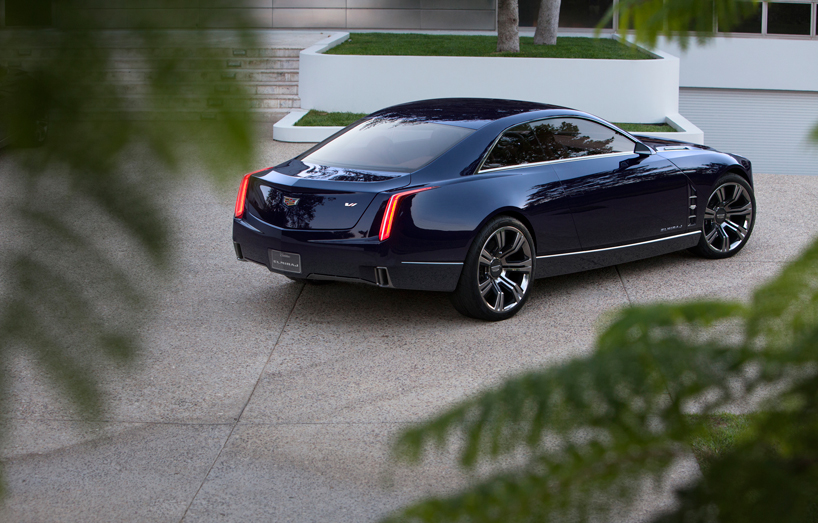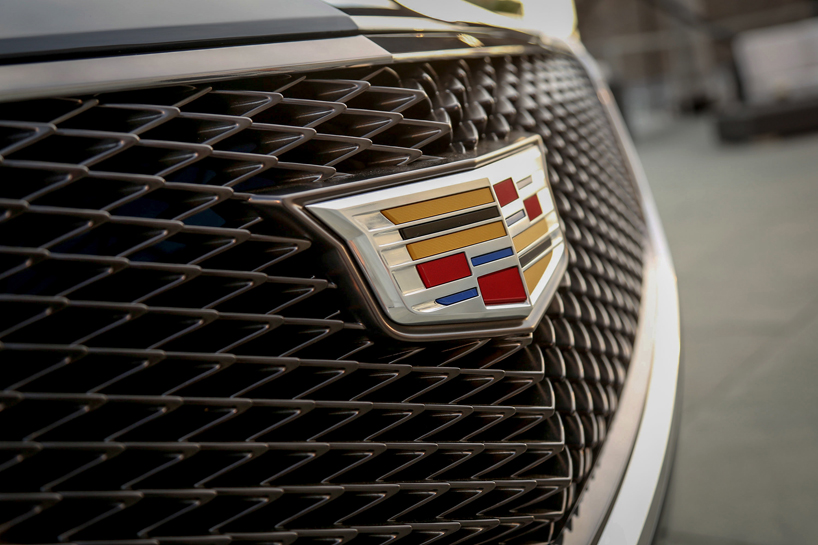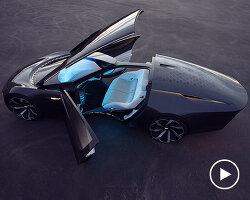
cadillac elmiraj concept produced with structured-light 3D scans
all images courtesy GM
in advancing the philosophy of dramatic design and performance, cadillac has developed the ‘elmiraj concept’, a grand coupe that showcases new dimensions for cadillac’s ongoing expansion as a global luxury brand. constructed with a chassis and structural elements from an ongoing cadillac vehicle development project slated for future production, the one-off sports car uses structured-light 3D scanning for its conception; an advanced measuring technology often used for fine art restoration and reproduction. to better understand the process of the 500 horsepower twin-turbocharged 4.5-liter V8 elmiraj coupe, designboom has a chat with clay dean, director of GM advanced design and david bolognino, director of GM design fabrication operations on the role of 3D scanning and the future of transportation below.

designboom: can you explain your role as the director of GM advanced design?
clay dean: advanced design is kind of an activity at GM, where we try to look down the road beyond the noise of production cars which take a lot of effort, to try to understand the trends, the opportunities and the competition — how do we get a leg up, how do we try to create visions and ideas that are really in the 10-15 year space that we believe will give us the advantage. new vehicle types, new types of vehicle services, new types of forms, shapes and features. it is really an opportunity to take that white piece of paper and craft what could be.
my role is to direct the over 200 designers we have here in michigan, we have a studio in california, we have advanced studios in korea, australia, germany and china — and we all try to coordinate our activities together; take the input that all the regions have so we can learn from it, so we can grow. and then we can also make sure that all the resources we have at GM — whether it be design, fabrication, engineering can all be applied to the needs around the world.

designboom: can you explain your role as director of GM design fabrication operations?
david bolognino: my role is to manage all the design centers’ fabrication activities — so, sort of behind the glamourous part if you will — of the design is the fabrication shops where we have significant capability to produce all of the 3D properties that the designers need to do their work.
while we don’t do clay — its basically the only thing we don’t do — we create everything that’s underneath the clay models, all of the hard parts that are on the clay models, we do various seating box 3D verification properties, and this is all used in the vehicle development process to confirm the design decisions that the creative designers and engineers are making. in addition to that, we support various other activities; we support the aerodynamics labs with the models that they need, we do a lot of jigs, fixtures for our pre-production fabrications. we create a majority of the concept cars that the corporation uses, as well as SEMA properties for the SEMA shows and various other auto shows. so within our four walls, we have the ability to create everything for a concept car with the exception of wheels and glass. the elmiraj is an example of car — while it was designed in the california studio — was almost entirely built in the fabrication shops in michigan.

designboom: was 3D scanning a big part of the development process?
david bolognino: well, 3D is a big part of all the development processes these days in design. it starts with clay’s team, using the 3D scanning to iterate between the clay model which might be hand sculpted if you will, and transcends that from clay to math and vise-versa. relative to fabrication, we use it more in fabrication as an inspection tool. we capture the clay and the math data in the models, molds and parts.

designboom: when designing a luxury vehicle like the elmiraj, what were the greatest challenges cadillac designers faced during the process?
clay dean: well there’s a lot of them! I’ll be honest with you, whether its a luxury vehicle or a sports vehicle — anything we take on as a challenge, probably the biggest challenges initially are to balance and manage everything in time — it seems like we always run out of time too soon for our deadline (laughs).
the biggest question we always start of with is why are we doing this project in the first place, these vehicles can be really time consuming to put together and pretty expensive. probably the biggest challenge up front is why we’re doing this concept. is there justification in it? will we learn anything from it? what are we going to learn as we’re designing it? do we know who we’re really targeting? they really are strategic activities to identify opportunities for us in the future or to test ideas. so once you get past all that, the next biggest challenge, is to find the theme. we’ll shake out a lot of ideas to find that new thing, and obviously since we’re in advanced, one of the things we’re trying to identify is: where does cadillac design go next?
in the case of the elmiraj, the things that will be fresh and dynamic that will be captivating to the audience we’ve identified in a time frame that we’re looking at. what will people pay attention to in what we’re creating, that will take their eye off of the competition? and that seems to push the designers and sculptors really, really, hard, because once you put the sketch together, you need to now pursuit it in three dimension, and to find the shapes and the forms that might capture the feeling and emotion of the sketch. that becomes a big challenge.

designboom: what was the inspiration for the elmiraj concept?
clay dean: part of the story of the elmiraj was: what is the true meaning of luxury in an automobile? and for the team, one of the biggest things we wanted to understand and explore was; when we think of luxury – when we think of tier 1 luxury ( that’s where the big players are in the automotive world) what does it take to be tier 1 luxury, and do we know what that is? that was why we were doing the car in general, to make sure that we knew the organization — meaning GM — understood exactly what tier 1 luxury was all about. it wasn’t a retro concept or a nostalgic concept, it was really to paint a picture of tomorrow. but one of the areas was important, was that the vehicle was about true personal luxury, and you can’t get more personal than a 2-door coupe, because it’s really selfish and places a high importance on style, flair and design. and in the history of cadillac over the past 100 years or so, we’ve had some pretty amazing, expressive 2-door vehicles. and so there were several vehicles for us certainly stood out in terms of influences and philosophy.
within GM we have a philosophy that’s more internal than external, we call it ‘art & science’. and the art & science was adopted in around 2000 here at cadillac, and what it was meant to do was to inspire the creative teams that were working at cadillac to capture what made cadillac great in its hay day like in the 1930’s in america. and in that time, art & science really was a component of the team. the artist is always pursuing his greatest work, and he’s probably never happy, because even if he accomplishes one thing, he’s looking for the next, looking for perfection, and he’s going through different sequences of creativity of form and shape, and so the artist is always in search for his greatest work.
with science, it keeps evolving on a daily basis. it’s something you’re always pushing for the next new thing, whether it be propulsion, or materials, manufacturing or even electronics. so for us, art & science was this magical journey to this destination that had no finality. it always kept us motivated and going forward. so all of these previous coupes in the past from cadiilac, we pulled in influences from this 1937 V16 stationary coupe, so selfish, so sophisticated, it had this proportion that was just amazing in terms of dash to axel, and long wheelbase, and extremely low it was an amazing vehicle. there was this 1965 brougham coupe deville, it was kind of the epitome of mid-century modern design, just a really strong component of cadillac, just long, acres of perfectly tailored sheet metal, and proportion. and then of course another vehicle that had a heavy influence was a 1967 eldorado, which to this day is really an iconic vehicle for us in design because it was really provocative. those three cars, singled out were the greatest inspiration for the elmiraj.

designboom: how do you keep a level of consistency when designing a concept vehicle? how does the elmiraj maintain ethos of the brand identity of cadillac?
clay dean: it’s a little more difficult in advanced design because you’re looking at everything you’re looking at today, and there’s a consistency within the production studio of the work we see on the body design, surface design, front and rear graphics, headlight design. now when we get to advanced, when we keep looking 5-10 years down the road, I really want to try to lead the story, but I don’t want to do exactly what’s happening in the studio today because I want to create a new story. I want something that may inspire the production studio to move to another step. but, when we look at certain things like vertical headlight signatures, those are things that are iconic for us here at cadillac, and that’s one thing that we need to hang onto, and take them to another level and the technology that is within them.
there’s a basic shape around the periphery of the face of the grill. there’s this shield shape grill, that for us is very important. although the proportions, forms and shape on the elmiraj are a lot different than some of the other vehicles in production today, it is unmistakable that the element is still there. so some of these elements we want to hang onto, the shield shaped-grille, vertical lighting, those are things you can put your finger on and go, ‘oh that is cadillac’, then it gives you little more latitude to be a little more progressive and creative with the design of the car.
designboom: do you think the shield-shaped grille was one of the most emphasized elements of design on the elmiraj?
clay dean: yeah I would say so. I think when you look at the front of the car, the two thing working in relation with each other, the shield-shaped grill and vertical headlights.

designboom: can you tell us why and how was 3D scanning used in development and creation of the elmiraj?
david bolognino: it’s interesting, the 3D scanning is almost a outgrowth of simplistic surface taking. back then, before digital tooling, we used to record surfaces just by taking points, you’d string several points together around the car, to showcase where surface was. the digital tools have made that very easy and far more detailed and comprehensive.
when we start a design in the 3D modeling stage — sometimes that model will start digitally in alias, where we can work around a package, meaning where the wheels are, the track, the height, etc.. and we will start to capture the sketch by building surfaces and planes, and curves, fillets and radii. sometimes we’ll just jump right in with a scale model with a sculptor, and begin manually manipulating surfaces. each one has its benefit, and sometimes one is faster than the other. but once we get to a certain point, where we’re happy where the surfaces are, many times we will scan that. we need to know where we are at any given time, so at certain points in the creative process, we’ll then scan that vehicle, pull that data from the surface back into our database. the whole process is iterative, because we can easily go back-and-forth from both processes.

designboom: can you talk about the role of 3D printing in the design process?
david bolognino: we use 3D printing quite a bit, we have a very large facility in north america, we use a couple different technologies. but it has absolutely key in the design process because it’s a way to quickly iterate designs out of the hard parts, and by hard parts I mean in the process of developing the clay, some of the items aren’t conducive to milling or producing in clay like lamps for example, some of the difficult and detailed grille textures and some of the interior parts. so in the creative process, this technology is absolutely key to getting quick iterations, and more iterations to our design team.
clay dean: when you think about what 3D printing might be able give you down the road in terms of amazing detail, or different texture, thats what on the designer’s side what intrigues us. there’s always going to be the question, can you do it fast enough, but what detail will it give you that you couldn’t create with a different manufacturing way.
david bolognino: well that’s right, because 3D printing has the ability to create something that you couldn’t conventionally tool. so if you’re using 3D printing to do a design verification that you will conventionally tool, you need to be careful with that, but if you’re you desire like on clay’s team to explore the possible, certainly 3D printing opens up another degree of freedom.

designboom: what are your thoughts on self driving cars and how do you envision the next 5-10 years of transportation?
clay dean: well you know, we are studying it, and there’s a bunch of activities that we are doing; we are pretty deep into it. there’s always the question; why are you doing it. to pursue something at that level, which is a pretty significantly industry and environment changing, what are the real benefits of that? so when we talk about autonomous driving cars, it’s interesting to how people think it’s going to change their lives. whether it’s for valeting their cars at the shopping mall, or going to sleep on from LA to vegas on the freeway, but what are the benefits? when we really think of the benefits of autonomous, if it really does stick. there are some amazing stories, like ‘crashless’ cars that never crash into each other, we can begin think about what things we could take out like mass and weight from the vehicles to make them more efficient.
if it was a tool that allowed an aging population — a group who really loves their independence — to extend their ability to get around town. for someone who’s learning how to drive a car, as a parent, could they have a vehicle that has different modes, the car could compensate their ability to do certain things, so as they learn and get more experienced, the car would give them more control. so when you think about autonomous, its more about just, ‘can the car drive itself’, it’s all these other things that would make driving better.
even from a performance point of view. could imagine if you had a corvette, and the car could help your learn how to drive fast? you could go to the track and pull out an app, and the car would take you around the track and show you where the braking points are, acceleration points are, where the turn in’s are. then turn the controls back to you, and it would teach you, it becomes your tutor, and it can drive faster than you and helps you get better. I mean, there’s so many things that autonomous can do, that it has to happen sooner or later. and no doubt, I think you will see it in multiple applications in different parts of the world.

about cadillac:
cadillac has been a leading luxury auto brand since 1902. today cadillac is growing globally, driven by an expanding product portfolio featuring dramatic design and technology.
3D printing (803)
cadillac (9)
PRODUCT LIBRARY
a diverse digital database that acts as a valuable guide in gaining insight and information about a product directly from the manufacturer, and serves as a rich reference point in developing a project or scheme.












